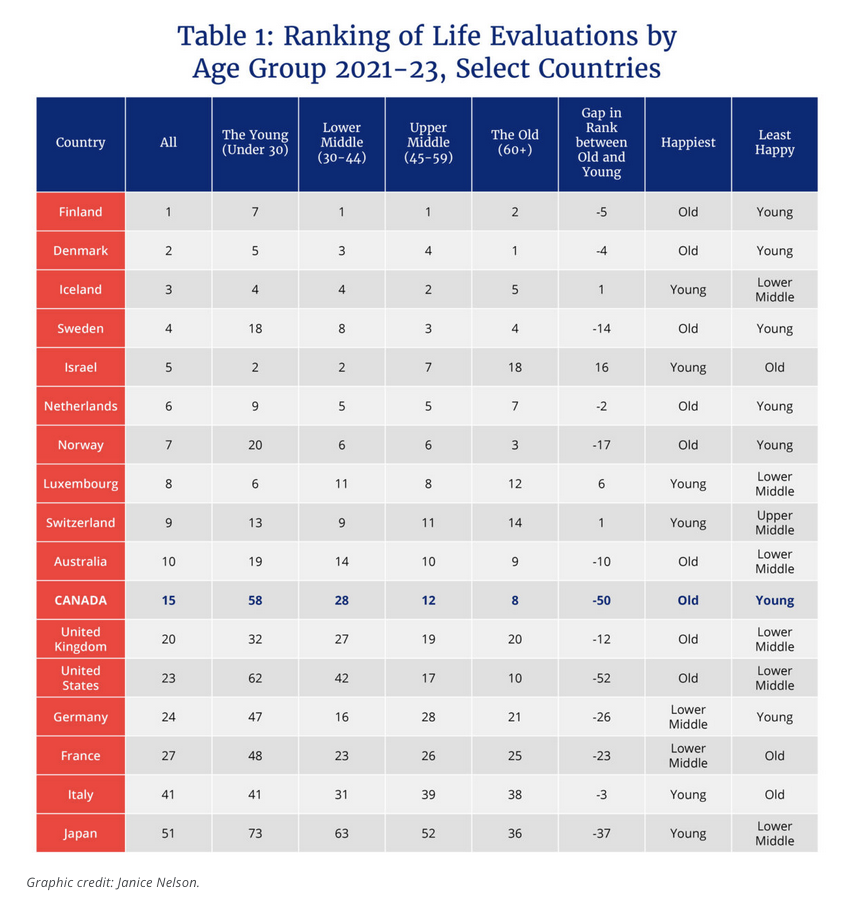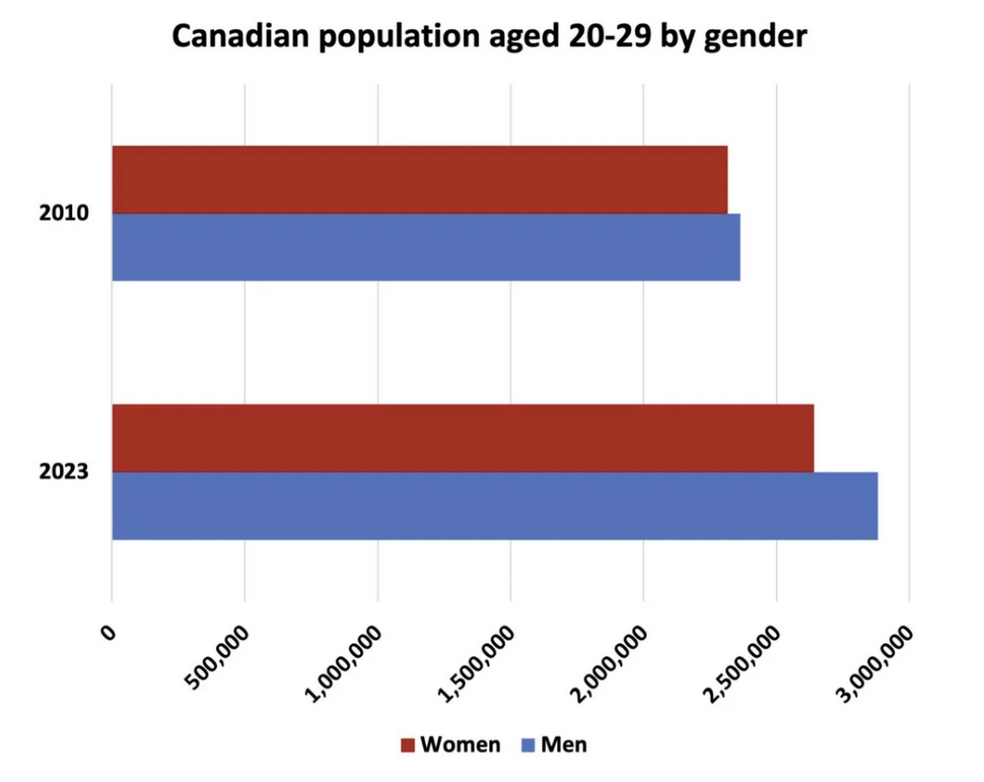In modern Canadian society, there’s a steep divide in the levels of happiness among different generations. In fact, youth satisfaction rates have plummeted for those born after 1980, while old man or lady, born before the 1980s, is reporting a boost in their overall happiness.

While it’s easy to point at Canada’s unafordable housing market as a primary source of why young Canadians are angry, recent polls and my personal conversations with my youngin’ friends back in Canada suggest that the root causes run much deeper than merely an inability to purchase property.
In this article I will unveil the uncomfortable truths behind the growing discontent among Canadian youth—a trend that is now, alarmingly, beginning to affect other Westernized youth as well. We’ll explore the reasons behind their increasing frustration, unhappiness, anger, and mental health challenges, comparing their experiences with those of previous generations.
Join me as we delve into these pressing issues, uncovering the significant societal shifts and technological advancements that are shaping the attitudes and futures of our younger populations.
1. Why Young Canadians are Angry: The Impact of Technology on Canadian Youth
The growing discontent among young Canadians can be largely attributed to the relentless pace of technological innovation that has defined their adolescence and early adulthood. The introduction of social media, dating apps, and artificial intelligence has not only reshaped their social interactions but has also had profound effects on their mental health and personal development.

Social Media – Warping Reality
Social media platforms, while connecting us to the world, have also been detrimental, diminishing attention spans and distorting perceptions of success.
It’s become alarmingly common for youth to engage in questionable or unethical behaviors to gain online validation and attention. This constant chase for digital approval triggers an addictive rush of dopamine, which can severely warp their understanding of traditional societal values.
Dating Apps – Screwing up Dating
Dating apps, too, have revolutionized the romantic landscape, but not without consequences. They have altered traditional dating dynamics, creating a competitive environment that often favors a small percentage of highly attractive individuals. This uneven playing field can leave many feeling excluded and undervalued, contributing to a sense of isolation and frustration among both men and women, although it appears to affect men disproportionately.
Screens Reducing Social Gatherings
Moreover, the shift from physical social gatherings to digital interactions has marked a significant change in how entertainment and leisure are perceived and experienced. Gone are the days when one would simply call friends to meet up for a movie or a casual hangout. Today, interactions are often limited to text messages, group chats, and the sharing of memes. This shift not only reduces face-to-face communication but also heightens impulsivity and aggression, as more young Canadians turn to their devices instead of engaging in real-world social activities.
The widespread adoption of these technologies is unprecedented, and the full scale of their impact is only now becoming apparent. As we navigate this new digital era, it is crucial to understand and address these challenges to foster a healthier, more balanced society.
2. The Male to Female Gender Imbalance in Canada
In recent years, Canadian government policies have aggressively pursued an increase in the country’s younger population as a bulwark against the demographic challenges of an aging populace. While these efforts are intended to rejuvenate the workforce and support the economy, they have inadvertently skewed the gender balance, particularly among those aged 25 to 44.
According to Bloomberg Canada, during the 2023-2024 period, the male to female ratio in this age bracket favored men by an additional 4.8 percent compared to women at 3.9 percent—a difference that translates to approximately 141,000 more men than women.
Historically, Canada maintained a near-even gender distribution from the 1970s through the 2010s. However, the imbalance becomes even more pronounced among younger Canadians. In the 20 to 29 age group, there is nearly a half-million more men, or a 9 percent greater proportion of men compared to women.

This demographic shift has profound implications for Canadian society. A surplus of young men, coupled with limited societal roles and economic opportunities, can lead to significant social challenges. Statistically, younger men and individuals without familial or societal bonds—such as marriage or homeownership—are more likely to engage in criminal activities, driven by fewer stakes in societal conformity and traditional roles that often socialize men to be more aggressive.
The potential for social unrest is not just theoretical. An unreleased RCMP report hints at a brewing discontent among Canadians under 30, driven by a realization that homeownership—a cornerstone of financial and social stability—is increasingly out of reach. The link between stable relationships and stable living conditions cannot be understated; without the ability to establish independent households, many young men are likely to postpone or forego marriage entirely.
The implications of these demographic and societal shifts are far-reaching. They signal a need for comprehensive policy adjustments that address not only the quantitative aspects of population management but also the qualitative impacts on community structure and individual well-being.
3. The Escalating Housing Affordability Crisis in Canada
A heavily redacted, RCMP report outlined housing unaffordability as one of the most significant threats facing Canadians in the next decade. The inability to secure stable, affordable housing is not just an economic issue—it’s a catalyst for social unrest. Historically, when young people are deprived of the opportunity to establish and raise a family in a stable environment, their frustration can lead to significant social upheaval.

Across Canada, the manifestation of this crisis is evident in the proliferation of tent cities. These makeshift communities symbolize the dire situation of many Canadians who, faced with exorbitant housing costs, find themselves on the brink of destitution. Lacking a stable environment, these individuals often feel they have nothing to lose, which can escalate their frustration into outright rebellion or, at the very least, a growing collective anger.
The options for affordable housing are rare, and the few available are typically located far from high-paying jobs. This creates a vicious cycle—a catch-22 situation—where the only affordable living options are positioned in areas lacking economic opportunity, further exacerbating the difficulty of achieving homeownership or even renting in or near urban centers where employment opportunities are concentrated.
This housing crisis requires urgent attention and innovative solutions. Without intervention, the dream of homeownership will continue to slip away for many young Canadians, potentially leading to greater societal instability and increased public dissatisfaction.
4. The Reduction of Young People’s Purchasing Power in Canada
The dream of homeownership through hard work and saving is now out of reach for most Canadians. It was once common for a $50,000 down payment to secure a home on 4 acres. But today, that amount will barely cover the cost of a new truck.
Sadly this is just the tip of the iceberg illustrating the stark decline in Canadian purchasing power, a trend that was exacerbated by the COVID-19 pandemic but had roots extending into the pre-pandemic era.
Factors Contributing to Reduced Purchasing Power:
Rising Inflation: Post-pandemic economic recovery efforts have led to significant government spending, including stimulus checks and expansive government programs. While these measures were designed to stabilize the economy, they have also contributed to heightened inflation, diminishing the value of the Canadian dollar.
Increased Interest Rates: In response to inflation, the Bank of Canada has periodically raised interest rates in an attempt to curb spending and stabilize the economy. However, these increased rates have also made borrowing more expensive, directly impacting the ability of Canadians to afford homes as mortgage rates climb.

Productivity Crisis: Another critical issue is Canada’s lagging productivity, particularly in comparison to its southern neighbor, the United States. Canadian workers are producing less value per hour worked, a gap that significantly impacts economic growth and the ability of businesses to expand and pay higher wages.
Decline in GDP Per Capita: Alongside productivity issues, Canada has experienced a decline in GDP per capita, indicating not just a stagnant economy but one that is struggling to keep pace with population growth and global economic dynamics.
Innovation Shortfalls: The Canadian market is also grappling with challenges in fostering high-level innovation across key sectors. Without significant breakthroughs or technological advancements, economic growth remains tepid, further weakening purchasing power.
These factors collectively paint a grim picture for young Canadians hoping to own property and secure financial stability. The erosion of purchasing power is not merely an economic statistic; it represents a profound shift in the quality of life and future prospects for an entire generation. Addressing these issues will require a multifaceted approach involving policy reforms, economic strategies to boost productivity, and efforts to stimulate innovation and technological adoption.
Charting a New Path Forward
As we have explored, the challenges facing young Canadians today—from skewed gender ratios and housing unaffordability to a significant decline in purchasing power—are not just temporary setbacks but symptoms of deeper systemic issues. These challenges demand not just awareness but action if you’re looking to live your Canadian dream.
For those who feel that these conditions severely limit their life choices and opportunities, it may be time to consider alternatives. Whether it’s the pursuit of more affordable living, better job prospects, or simply a change in lifestyle, the decision to explore new horizons is both valid and increasingly common.
If you’re contemplating such a decision, the Canadian Exit Guide could be your first step toward a new beginning. This comprehensive guide is designed to help you navigate the complexities of relocating from Canada, offering practical advice, detailed information on potential destinations, and real-life considerations for Canadians looking to set roots elsewhere.
As we continue to advocate for improvements and solutions at home, the Canadian Exit Guide provides an invaluable resource for those ready to take control of their futures in a new setting. Explore your options, empower yourself with knowledge, and take the steps necessary to secure a fulfilling and prosperous future, wherever that may be.
Remember, sometimes the bravest choice is to make a change. The Canadian Exit Guide is here to help you make that change informed and confident.


Leave a Reply